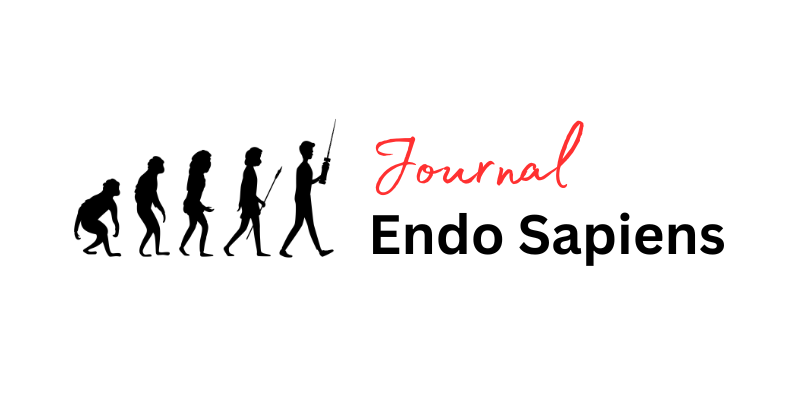

Before submitting:
Read the Aims&Scope to gain an overview and assess if your manuscript is suitable for this journal;
Make sure that issues about publication ethics, research ethics, copyright, figure formats, and references format have been appropriately considered;
Ensure that all authors have approved the content of the submitted manuscript and confirm that they read the Instructions for Authors.
Manuscript Submission Overview
Types of Publications
Manuscripts submitted to Endo Sapiens journal should neither be published previously nor be under consideration for publication in another journal. The main article types are listed below.
- Article: These are original research manuscripts. The work should report scientifically sound experiments and provide a substantial amount of new information. The article should include the most recent and relevant references in the field. The structure should include an Abstract, Keywords, Introduction, Materials and Methods, Results, Discussion, and Conclusions (optional) sections.
- Review: Reviews offer a comprehensive analysis of the existing literature within a field of study, identifying current problems. They should be critical and constructive and provide recommendations for future research. No new, unpublished data should be presented. The structure can include an Abstract, Keywords, Introduction, Relevant Sections, Discussion, Conclusions, and Future Directions.
- Case Report: Case reports can illustrate unusual, clinically relevant and new observations. Illustrative material should be demonstrated an extended period after treatment. The structure should include: Introduction, report, discussion and conclusion
Submission Process
This journal operates under a double-blind peer review model. Except where otherwise stated, manuscripts are peer reviewed by at least two anonymous reviewers and an Associate Editor. Papers will be sent to review after the Editor-in-Chief determines that the paper meets the appropriate quality and relevance requirements.
In-house submissions, i.e. papers authored by Editors or Editorial Board members of the title, will be sent to Editors unaffiliated with the author or institution and monitored carefully to ensure there is no peer review bias.
To submit your manuscript please visit the Article Submission Page.
Accepted File Formats
The total amount of data for all files must not exceed 120 MB.
We accept files in Microsoft Word: Manuscripts prepared in Microsoft Word must be converted into a single file before submission.
Preparing Figures, Schemes and Tables
Resolution, color and format:
- All figures should be of a high quality (preferably no less than 600 dpi) in PNG, JPEG or TIFF formats.
- Authors are encouraged to prepare figures and schemes in color (RGB at 8-bit per channel).
- Images should be combined to avoid any issues during formatting changes. There should be no editable parts in the images.
- All table columns should have an explanatory heading. To facilitate the copy-editing of larger tables, smaller fonts (no smaller than 8 pt.) may be used. Authors should use the “Table” option in Microsoft Word to create tables.
Reference format
The reference list should include the full title, as recommended by the ACS style guide. Style files for Endnote and Zotero are available.
References should be described as follows, depending on the type of work:
- Journal Articles:
1. Author 1, A.B.; Author 2, C.D. Title of the article. Abbreviated Journal Name, Year, Volume, page range.
- Books and Book Chapters:
2. Author 1, A.; Author 2, B. Book Title, 3rd ed.; Publisher: Publisher Location, Country, Year; pp. 154–196.
3. Author 1, A.; Author 2, B. Title of the chapter. In Book Title, 2nd ed.; Editor 1, A., Editor 2, B., Eds.; Publisher: Publisher Location, Country, Year; Volume 3, pp. 154–196.
- Unpublished materials intended for publication:
4. Author 1, A.B.; Author 2, C. Title of Unpublished Work (optional). Correspondence Affiliation, City, State, Country. year, status (manuscript in preparation; to be submitted).
5. Author 1, A.B.; Author 2, C. Title of Unpublished Work. Abbreviated Journal Name year, phrase indicating stage of publication (submitted; accepted; in press).
- Unpublished materials not intended for publication:
6. Author 1, A.B. (Affiliation, City, State, Country); Author 2, C. (Affiliation, City, State, Country). Phase describing the material, year. (phase: Personal communication; Private communication; Unpublished work; etc.)
- Conference Proceedings:
7. Author 1, A.B.; Author 2, C.D.; Author 3, E.F. Title of Presentation. In Title of the Collected Work (if available), Proceedings of the Name of the Conference, Location of Conference, Country, Date of Conference; Editor 1, Editor 2, Eds. (if available); Publisher: City, Country, Year (if available); Abstract Number (optional), Pagination (optional).
- Thesis:
8. Author 1, A.B. Title of Thesis. Level of Thesis, Degree-Granting University, Location of University, Date of Completion.
- Websites:
9. Title of Site. Available online: URL (accessed on Day Month Year).
- Unlike published works, websites may change over time or disappear, so we encourage you create an archive of the cited website using a service such as WebCite. Archived websites should be cited using the link provided as follows:
10. Title of Site. URL (archived on Day Month Year).
Cover Letter
A cover letter must be included with each manuscript submission. It should be concise and explain why the content of the paper is significant and should explain why the manuscript fits the scope of the journal.
All cover letters are required to include the following statements:
- We confirm that neither the manuscript nor any parts of its content are currently under consideration for publication with or published in another journal.
- All authors have approved the manuscript and agree with its submission toEndo Sapiens journal.
Author Identification
Short information about authors should contain:
- Authors’ full names followed by current positions;
- Education background including institution information and year of graduation (type and level of degree received);
- Work experience;
- Current and previous research interests;
- Memberships of professional societies and awards received.
Author Affiliation
All authors should list their current affiliation and the affiliation where most research was carried out for the preparation of their manuscript. We recommend adding as primary the affiliation where most of the research was conducted or supported, but please check with your institution for any contractual agreement requirements.
It is very important that author names and affiliations are correct. Incorrect information can mean a lack of proper attribution or incorrect citation and can even lead to problems with promotion or funding. After the publication of an article, updates or corrections to the author’s address or affiliation may not be permitted.
Independent Researcher
If one or all the authors are not currently affiliated with a university, institution or company, or have not been during the development of the manuscript, they should list themselves as an “Independent Researcher”.
Research Ethics
Research Involving Human Subjects
Institutional Review Board Statement
When reporting on research that involves human subjects, human material, human tissues, or human data, authors must declare that the investigations were carried out following the rules of the Declaration of Helsinki of 1975, which was revised in 2013. According to point 23 of this declaration, approval from the local Institutional Review Board (IRB) or another appropriate ethics committee must be obtained before undertaking the research to confirm that the study meets national and international guidelines. As a minimum, a statement including the project identification code, date of approval, and name of the ethics committee or institutional review board must be stated in the ‘Institutional Review Board Statement’ Section of the article.
Example of an Institutional review board statement: “The study was conducted in accordance with the Declaration of Helsinki, and the protocol was approved by the Ethics Committee of XXX (Project identification code) on [date of approval].”
Publication Ethics Statement
Authors wishing to publish their papers in Endo Sapiens journal must abide to the following:
- Any facts that might be perceived as a possible conflict of interest of the author(s) must be disclosed in the paper prior to submission.
- Authors should accurately present their research findings and include an objective discussion of the significance of their findings.
- Data and methods used in the research need to be presented in sufficient detail in the paper, so that other researchers can replicate the work.
- Raw data should preferably be publicly deposited by the authors before submission of their manuscript. Authors need to at least have the raw data readily available for presentation to the referees and the editors of the journal, if requested. Authors need to ensure appropriate measures are taken so that raw data is retained in full for a reasonable time after publication.
- Simultaneous submission of manuscripts to more than one journal is not tolerated.
- If errors and inaccuracies are found by the authors after publication of their paper, they need to be promptly communicated to the editors of this journal so that appropriate actions can be taken.
- Your manuscript should not contain any information that has already been published. If you include already published figures or images, please obtain the necessary permission from the copyright holder to publish under the CC-BY license.
- Plagiarism, data fabrication and image manipulation are not tolerated.
Plagiarism includes copying text, ideas, images, or data from another source, even from your own publications, without giving any credit to the original source. Reuse of text that is copied from another source must be between quotes and the original source must be cited.
All submissions in Endo Sapiens journal are checked for plagiarism using the industry standard software iThenticate. If plagiarism is detected during the peer review process, the manuscript may be rejected. If plagiarism is detected after publication, an investigation will take place and action taken in accordance with our policies.
Image files must not be manipulated or adjusted in any way that could lead to misinterpretation of the information provided by the original image.
Irregular manipulation includes: 1) introduction, enhancement, moving, or removing features from the original image; 2) grouping of images that should obviously be presented separately; or 3) modifying the contrast, brightness or color balance to obscure, eliminate or enhance some information.
If irregular image manipulation is identified and confirmed during the peer review process, we may reject the manuscript. If irregular image manipulation is identified and confirmed after publication, we may correct or retract the paper.
Copyright and Licensing
For all articles published in Endo Sapiens journal, copyright is retained by the authors. Articles are licensed under an open access Creative Commons CC BY 4.0 license, meaning that anyone may download and read the paper for free. In addition, the article may be reused and quoted provided that the original published version is cited. These conditions allow for maximum use and exposure of the work, while ensuring that the authors receive proper credit.
In exceptional circumstances articles may be licensed differently. If you have specific condition (such as one linked to funding) that does not allow this license, please mention this to the editorial office of the journal at submission. Exceptions will be granted at the discretion of the publisher.
